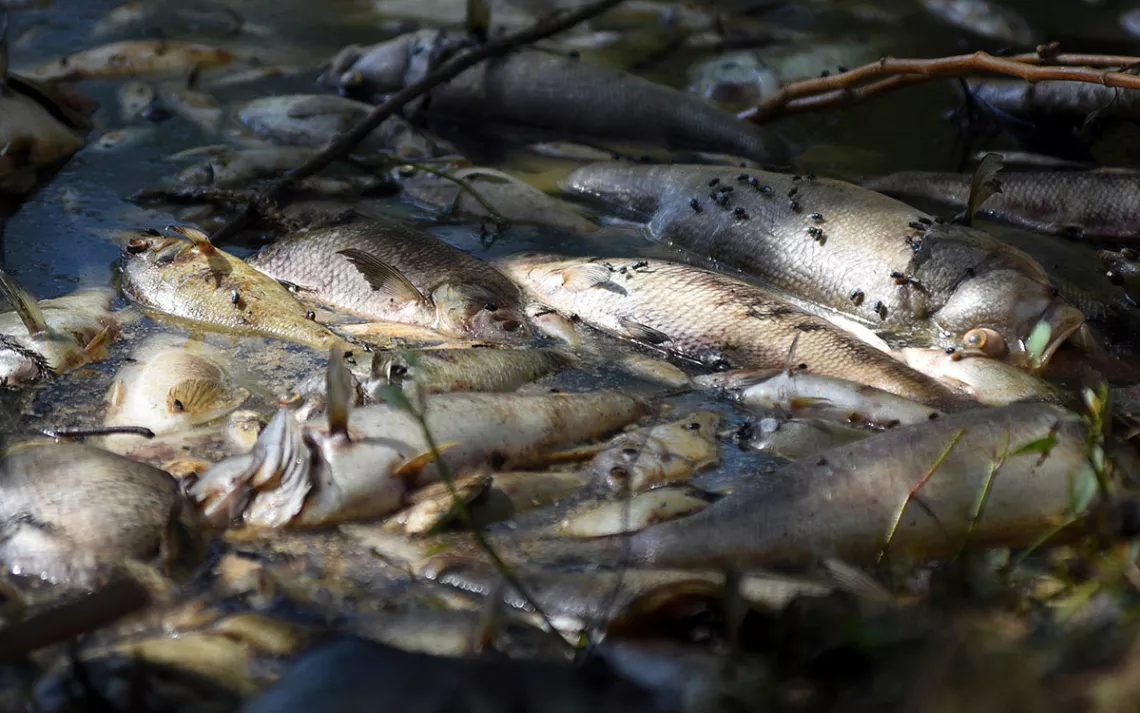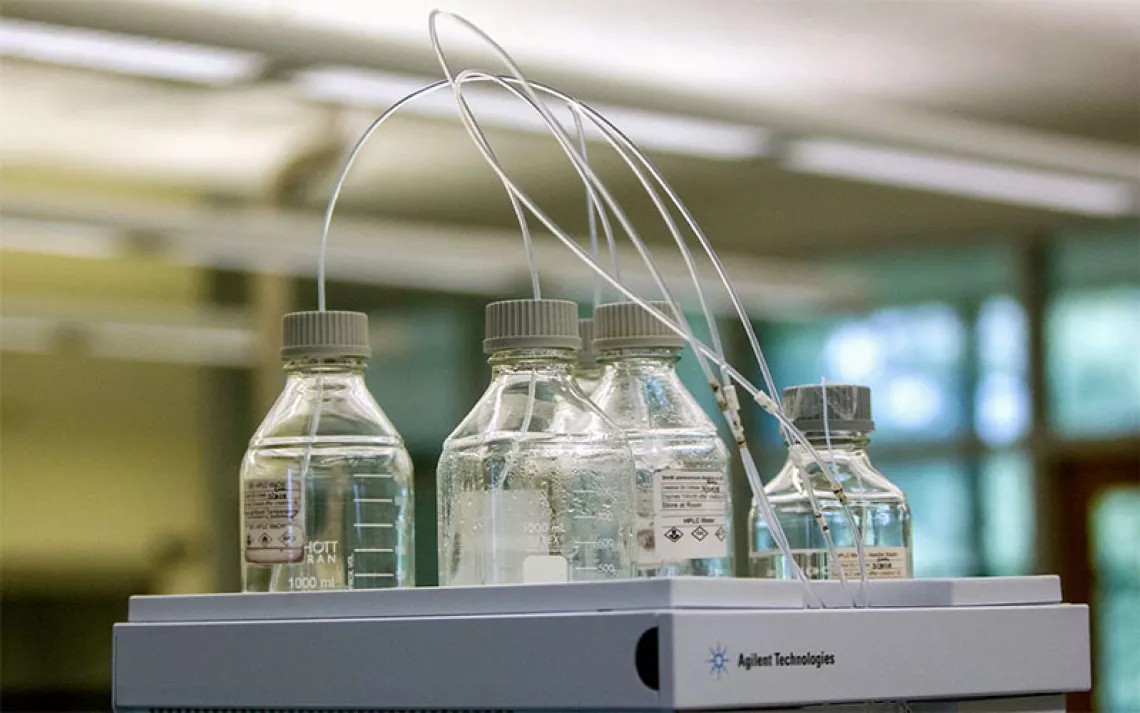North Carolina Agency Warns Anglers About Poisoned Fish
New dangers in the Cape Fear River threaten recreational and subsistence fishing

Floodwaters from the Cape Fear River cover Water Street in Wilmington, North Carolina, in 2018. | Photo by Matt Born/The Star-News via AP
The coastal areas around Wilmington, North Carolina, are renowned for their year-round recreational and subsistence fishing. Whether freshwater species like the largemouth and striped bass or saltwater species like speckled trout, red drum, and bluefish, something is always biting in the Cape Fear River and its tributaries. But on a beautiful Indian summer morning in November, just five miles from the downtown Riverfront, the 125-foot fishing pier in Brunswick Riverwalk Park, usually lined with anglers, is completely deserted.
Last July, the North Carolina Department of Health and Human Services (NCDHHS) issued a fish consumption advisory recommending nearly everyone dramatically cut their intake of certain freshwater fish from the middle and lower Cape Fear River. This advisory was prompted by concerns that fish are exposed to perfluorooctane sulfonic acid (PFOS), a toxic polyfluoroalkyl substances (PFAS) chemical that can persist for 1,000 years. According to the commission's survey, the species most frequently caught and consumed were found to have the highest levels of PFOS.
PFAS is increasingly seen as an emerging public health concern that can cause issues with reproductive health, increase high blood pressure in pregnant women, create developmental defects in children, and elevate the risk of some cancers. Known as forever chemicals because of its inability to degrade, PFAS can also be called everywhere chemicals because they’re found in so many commonly used products, including nonstick cookware, water-repellent clothing, stain-resistant fabrics and carpets, cosmetics, and firefighting foams.
The state advisory from July suggests eating just one American shad, blue catfish, or channel catfish a year. And, because the striped bass has one of the highest documented rates of PFAS of any North American fish, the state health agency warned against consuming the popular recreational fish in any quantities. Advisory limits are even lower for women and children since these groups may be more sensitive to PFAS exposure. In the announcement, the state officials warned that these groups should be especially cautious about consuming fish from the Middle and Lower Cape Fear River and advised everyone to consume no more than seven meals each year.
The Cape Fear River is 200 miles of foaming rapids and tranquil eddies that flow through east-central North Carolina. The lower river basin is among the most biodiverse places on the Eastern Seaboard, with a heady mix of common, endemic, rare, threatened, and endangered species. The river is also the source of drinking water for more than 500,000 people from central Greensboro to coastal Wilmington.
Residents first learned about the problem in mid-2017 thanks to a front-page story in the Wilmington Star News, which documented the findings of an earlier NC State research study that detected alarming amounts of unregulated PFAS, called GenX, in drinking water from Wilmington’s municipal water district. The source of the contamination was traced to fluorochemical manufacturer Chemours, a spin-off of DuPont. Beginning in the early 1980s, the company’s Fayetteville Works manufacturing facility, 80 miles upstream, routinely dumped large quantities of the synthetic chemicals into the Cape Fear River and released airborne toxins.
Erin Carey, the North Carolina state chapter director of the Sierra Club, had recently moved to the Wilmington area in 2017 when news of the chemical contamination broke. “The idea that we had been unwittingly consuming this chemical for all these years, and at that point, nobody knew how toxic it was or what the concentrations were or what that meant,” Carey said. “All we knew is that some people had been drinking the water for decades.”
Clean Cape Fear, a community action group formed in response to the PFAS contamination, along with several environmental and social justice groups, filed suit against the Environmental Protection Agency to gain access to health studies. “Our focus has always been on reducing PFAS exposure, the [knowing the] health risks, and making polluters pay,” Emily Donovan, Clean Cape Fear’s [co-]founder, said.
Following a successful court case by Cape Fear Riverwatch, Chemours was ordered to pay $13 million in penalties and costs to the Department of Environmental Quality, address PFAS sources and contamination, and provide safe drinking water to affected homes. Nonetheless, area environmental groups continued to press state regulators to monitor the safety of the food supply. “Our region is super saturated with PFAS, the majority of it coming from the Chemours facility at Fayetteville Works,” Donovan said. “We've always wondered if our food supply is contaminated, not just fish but game and produce.”
The North Carolina Department of Health and Human Services initially planned to only issue fish consumption advisories for areas near the Chemours facility. In February 2022, Clean Cape Fear persuaded the agency to include the area near downtown Wilmington and to the ocean, where there is significant subsistence fishing.
Epidemiologists from the NC Department of Health and Human Services collected and tested the most common species in the rivers. Levels of PFOS were higher in bluegill, flathead catfish, largemouth bass, striped bass, and redear and lower in American shad, blue catfish, and channel catfish, according to the advisory. In the meantime, Clean Cape Fear, the Duke University Superfund Research Center, and several local nonprofits launched the Stop, Check, and Enjoy!, a grant-funded program to make communities aware of the potential risks of chemical contamination in different fish species.
Fish advisories are not mandates. They are simply recommendations to help consumers make informed decisions about their consumption. The recommendations, which range from “do not eat” to “eat only one meal per week,” are based on the new lower PFOS reference dose cited by the Environmental Protection Agency in March 2023. While the advisories do not factor in the increased risk for communities that have long been dealing with overexposure from PFAS, they are nonetheless some of the strictest in the country.
The impact of PFAS on fishing is being felt more acutely among some Black and Indigenous populations for whom fishing in the Cape Fear is not only a long-held tradition but also a vital source of protein they routinely share with friends and family. According to the North Carolina Department of Environmental Quality, county agencies issued more than 20,000 subsistence waivers to residents who receive Medicaid, SNAP benefits, or Work First Family Assistance to fish free of charge in any of the state’s waterways. Wilmington native Deborah Maxwell grew up eating fish from the Cape Fear River. “When my father fished, the whole neighborhood never knew a fish market until he stopped,” Maxwell said.
A June 2022 report from Duke University’s Superfund Research Center’s Community Engagement Core said the state’s process for setting fish consumption advisories doesn’t capture the full health risks and doesn’t account for the health impacts of multiple or emerging contaminants. This problem is hardly unique to North Carolina. Across the country, scientists are working to learn more about PFAS and their impact on health. Michigan, Wisconsin, and Pennsylvania also have issued PFAS fish advisories for specific sites. However, North Carolina was the first state to use the EPA’s new, more stringent reference doses.
Carey believes more resources and new approaches are needed to communicate the potential risks and alternatives to subsistence fishers. “There are many people doing subsistence fishing who have a language barrier,” Carey said, referring to many in the migrant and Indigenous communities for whom English is not their first language. “Where are you going to post signs? How are people going to know? How are we going to get this information to the people who are feeding their families and sharing it with their friends?”
That’s where she hopes outreach from the Stop, Check, and Enjoy! program will be particularly valuable. As part of Duke University’s Campaign for Subsistence Fish Consumers, members of the program help distribute brochures, wallet cards, posters, calendars, and social media tool kits to teach anglers about healthy fishing practices, such as steering clear of certain species and checking local PFAS advisories.
“Studies have documented the many benefits of eating fish,” Elizabeth Cuervo Tilson, the state health director and NCDHHS chief medical officer, said in the advisory press release when it was released. “We want residents to have these recommendations so they can make informed decisions about fish consumption, particularly if they regularly catch and eat fish from this part of the Cape Fear River.”
This feature was published with support from the Pulitzer Center for Crisis Reporting's Deep Dives grant fund. It has also been updated since its original publish date.
 The Magazine of The Sierra Club
The Magazine of The Sierra Club



